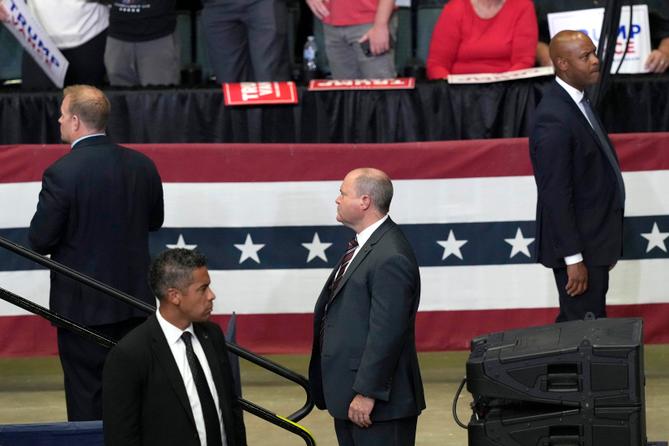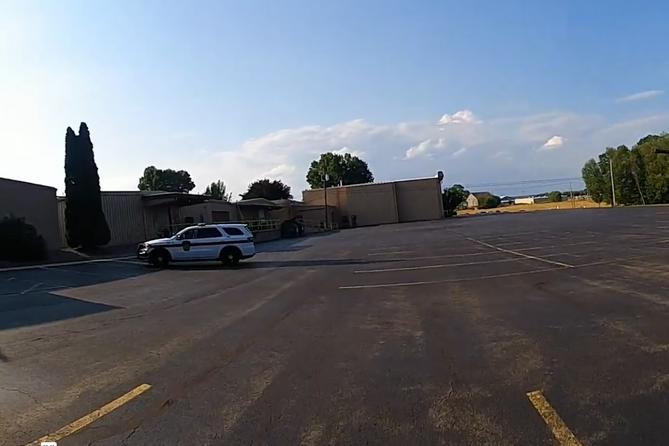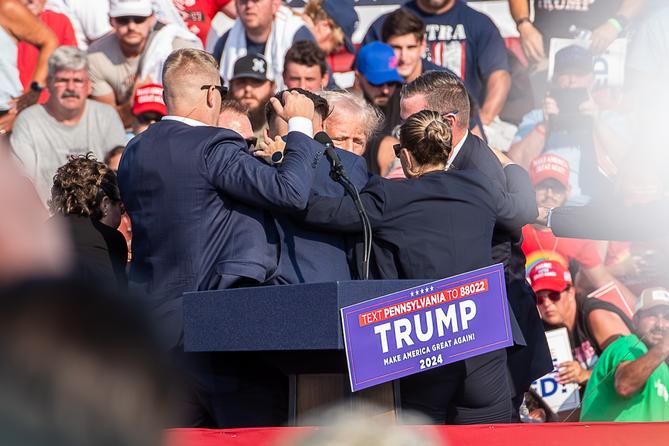He’d warned them.
Butler Township Police Officer Drew Blasko paced angrily along the AGR building, where just minutes before a gunman had clambered atop the roof, aimed an AR-15-style rifle at Donald Trump and fired, striking the former president.
As Blasko and other officers stood guard near a loading bay behind the building, he recounted a meeting earlier in the week with the Secret Service.
“I told them that fucking Tuesday,” he said. “I told them to post fucking guys over here.”
The Trump rally shooting that day, which killed one man and injured three others, including the former president, has been called the largest security failure in 40 years. It has led to the resignation of the Secret Service director, a congressional investigation and questions from lawmakers about how such a lapse could have occurred.
But an investigation by Spotlight PA, ProPublica and the Butler Eagle has revealed that the weaknesses that led to the assassination attempt were not unique to the July rally, but the inevitable breakdown of an already vulnerable system.
The newsrooms spoke to dozens of officials across all levels of law enforcement and in several states who have provided security for presidents and presidential candidates, as well as local party officials and academic experts in security.
The newsrooms did not speak directly with Blasko but obtained body-camera footage showing him and other Butler Township officers in the aftermath of the shooting. Efforts to reach Blasko were unsuccessful.
The reporting found the steps taken in the days leading up to the Butler rally largely mirrored the process the Secret Service has used for years to collaborate with local law enforcement before visits by presidents and other high-profile individuals under their protection — a process that the shooting revealed to be susceptible to attack.
“It’s pretty clear that it wasn’t just one screw-up here,” said Andrew Vitek, a professor who teaches about terrorism at Penn State University. “This is indicative of multiple systemic failures all coming down around their ears at once.”
The Secret Service did not respond to questions.
Large events involving presidential candidates are delicate, officials said, involving rapid coordination on little notice among federal, state and local law enforcement agencies.
Because the Secret Service is stretched thin, with 3,200 agents and another 1,300 uniformed officers to divide among more than 30 protectees, the agency relies on local law enforcement officers to help secure campaign events, though they do not have the same specialized training as federal agents.
The Secret Service holds a planning meeting with these partner agencies before an event, the same meeting Blasko described in released body-camera footage.
In Butler, attending officers described the meeting as informal and disorganized, said Butler County District Attorney Richard Goldinger, whose office oversees the county’s specialized emergency services unit that provided support on July 13. It left local officials to create their own operational plan for the day.
As a result, communications between multiple levels of law enforcement were a cobbled combination of radio command centers and cellphones.
Such difficulties are compounded when campaign rallies occur at open-air venues like the Butler Farm Show, where thousands of people gathered to hear Trump speak.
The newsrooms analyzed data from nine years of Trump rallies, which revealed that Trump’s signature campaign stops have evolved from largely indoor affairs in hard-to-penetrate arenas to include more public, outdoor spaces. This has shifted local law enforcement’s responsibilities from traffic control and intersection monitoring to guarding rooftops and anticipating potential shooters’ sightlines.
“If you’re not able to fully communicate that the guy with the gun is right there … then all of a sudden everyone is looking around trying to figure out how the hell this guy got a couple of shots off,” Vitek said.
Harder to defend
A perennial swing state, Pennsylvania is a favorite stop for presidential candidates vying for its 19 electoral votes. The former president is no different, holding his signature rallies in Pennsylvania at least 30 times since his first presidential campaign in 2016, more than any other state.
Initially, the Trump campaign had wanted to have the July rally somewhere more secure: the Pittsburgh-Butler Regional Airport, a tiny airstrip he’d used in 2020. The campaign reached out to the Butler County Airport Authority for permission.
But there was a conflict.
A local firehouse was slated to hold its annual Mega Car Cruise on the same day. The airport authority’s board knew how important the fundraiser was to the small volunteer department. So it rejected the Trump campaign’s request.
Instead of the easier-to-defend airport, with a single entrance and exit and fewer easily accessible buildings, the campaign picked the wide-open fields of the Butler Farm Show.
During his unsuccessful 2020 reelection campaign, Trump visited mostly airports, holding rallies either under cover of a hangar or on a tightly controlled airstrip directly after landing from a military plane or helicopter. But as his rally schedule became more crowded, it also became more varied.
In the years since he left office, nearly half of Trump’s rallies have been outdoors. Of these outdoor events, most have been in public spaces such as fairgrounds, downtown shopping districts or parks.
Indoor events pose their own complications, said Paul Eckloff, a former Secret Service agent who served under three presidents, including Trump. Arenas and convention centers are often in dense, urban areas near highways that could present a possible threat if someone wanted to turn a vehicle into an explosive device.
Outdoor events, though, are where your threat level “goes through the roof,” said a former officer with the Secret Service uniformed division who requested anonymity to discuss his service.
Outdoor locations are often built from scratch just for an event, making it more difficult for law enforcement agencies to control who gets in and out. Consequently, there’s a higher risk that a local law enforcement partner may encounter a threat they’re not prepared to meet.
As a former president and current candidate, Trump is entitled to some protection from the Secret Service. But it is not as extensive as that afforded to the sitting president and no longer includes access to the military.
This means as he has continued campaigning over the past three years, he has done so with less protection in more challenging environments.
While the Secret Service can raise security concerns about a venue, those warnings can go ignored by candidates and their campaigns, former employees of the agency said. It is unclear if Secret Service officials raised such concerns ahead of the Butler rally.
“We will remind them, ‘Respectfully, sir, ma’am, if you do this, you may not have a candidate, you may not have a leader, we may not have a leader, so please reconsider that,’” the former officer said.
Planning problems

It was 1 p.m.
The stage was set; the red, white and blue bunting hung; and the doors opened to Trump supporters eager to see the former president.
The local police, including SWAT teams from Butler Township and surrounding counties, had been in place for hours. But they still had not heard from the Secret Service, according to local police and Goldinger, the district attorney.
Initial security planning is often spearheaded through one of the Secret Service’s regional offices, which will reach out to state and local departments to request officers and assets, like a bomb unit or explosive-sniffing dogs. There is not typically a formalized, written agreement between them.
Local law enforcement officers are there to support the mission, said Ryan Windorff, president of the Wisconsin Fraternal Order of Police, but “it’s ultimately the Secret Service’s planning and decisions and experience that runs the day.”
In the days before an event, local, state and federal law enforcement will have a planning meeting to go over protocol, said Adam Reed, a spokesperson for Pennsylvania State Police. Officials described a similar sequence of events ahead of campaign outings over the past 12 years, regardless of the candidate or political party.
Close coordination is especially important in states such as Pennsylvania, home to more local police departments than any other state in the country.
But the pre-rally Butler meeting did little to assuage security concerns, according to local officials.
During the week leading up to the rally, representatives from all of the local police departments that had been asked to help secure the Trump event met in nearby Connoquenessing Township to coordinate.
The Butler County Emergency Services Unit, a special weapons and tactical squad, had toured the Butler Farm Show during the week and had identified the AGR building as a threat. In the meeting, Butler County officials raised the issue with the Secret Service, said Goldinger, the Butler County District Attorney, but ultimately, the agency did not post anyone on the roof.
“This was their ballgame,” Goldinger said of the Secret Service.
Local officers didn’t receive a written plan from the Secret Service until 1:30 p.m. on the day of the rally, according to Goldinger — 30 minutes after the doors opened. In the absence of such a plan, local supporting officers set up their own.
On the day of the event, local counter-snipers met with their counterparts in the Secret Service. But they had not been asked to secure or set up a perimeter, said Adams Township Sgt. Ed Lenz, who commands the Emergency Services Unit.
“I’m not sure that it was very clear to the overall Secret Service command what they had actually asked us to do,” Lenz said.
Communication breakdowns
At 4:26 p.m. on July 13, a Beaver County Emergency Services Unit sniper leaving his shift texted the remaining county officers stationed inside the AGR building.
“Someone followed our lead and snuck in and parked by our cars just so you know,” the text reads.
In the days since the rally, news reports and testimony before Congress have revealed the communications gaps that allowed Thomas Crooks to evade law enforcement for more than 90 minutes after the text was sent.
But the chain-link communication structure used in Butler was not new.
Local law enforcement officials providing security for past campaign events involving presidents also relied on a relay system to communicate because the different agencies do not share radio frequencies with the Secret Service or one another.
“And that creates communications problems,” said John Kiel, assistant chief of the Superior Police Department in Wisconsin.
Kiel heads a 58-officer department that provided support for an event for President Joe Biden on Jan. 25 alongside agencies from different jurisdictions and states, all with different radio frequencies or even different wavelengths.
“So generally, what happens is we have to have somebody from our agency directly working with, meaning you’re working hip to hip, with Secret Service,” he said. “And then, you know, that’s where the technology, with use of cellphones, really plays a big part.”
To coordinate, officials said, the Secret Service establishes a command post at a site such as the airport where the president or candidate is landing. Typically, leadership from every involved agency is present so they can relay information immediately.
But at Butler, two command centers were set up, Lenz said, one for State Police and the Secret Service and one for local police. Lenz and his officers communicated to the State Police, which passed on information to the Secret Service.
When the local sniper spotted Crooks and texted his unit, Goldinger said, other officers stationed inside the AGR building had to relay that information back to the local command, who then told the State Police, who then told the Secret Service.
But testimony from the acting Secret Service Director Ronald Rowe has revealed that the information never made it to the people who could take action to stop Crooks.
“It appears that that information was stuck or siloed in that state and local channel,” Rowe told U.S. senators in July. “Nothing about man on the roof, nothing about man with a gun. None of that information ever made it over our net.”
Increased security

Since the assassination attempt, Trump has held eight rallies, all indoors at the urging of the Secret Service.
Ahead of his scheduled rally in Wilkes-Barre, Pennsylvania, the Secret Service approved a new security plan, including bulletproof glass to shield the former president at outdoor events, according to reporting in The Washington Post.
On Aug. 12, a month after Crooks shot him, Trump said he plans to return to Butler to finish his speech.
During a conversation with billionaire Elon Musk broadcast on X, the social media platform Musk owns, Trump said he would be back to the rural Pennsylvania county sometime in October.
If Trump does return, Butler officials would like better coordination from the Secret Service, including a unified command post, Lenz said.
But despite Trump’s announcement, local officials had little information. They have a lot of worries.
Butler County Commissioner Leslie Osche said in a statement that although many residents would be excited to see Trump return, the community may not have completely healed from the trauma of the shooting.
“While this county has overwhelmingly welcomed and supported former President Trump, a return visit will place additional stress on law enforcement and the community,” Osche said. “I am angry. I am sad. I am disappointed.
“And I am waiting for the results of an investigation by qualified institutions instead of endless finger pointing.”
BEFORE YOU GO… If you learned something from this article, pay it forward and contribute to Spotlight PA at spotlightpa.org/donate. Spotlight PA is funded by foundations and readers like you who are committed to accountability journalism that gets results.
